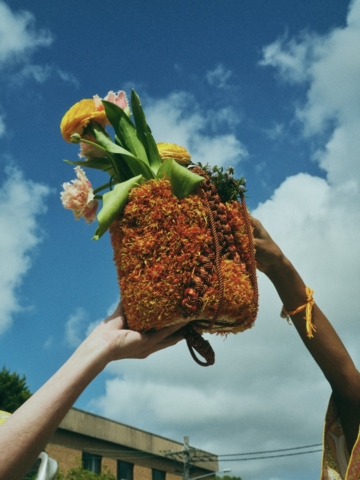Mash Up “Gorse and Tropē”
By Jo Phillips
LAMB arts newest presentation is “Gorse and Tropē” A two man show including works by James Hillman and Fernado Otero. The exhibition “Gorse and Tropē” relates to the ideas of the two separate words; with the meanings they convey. Tropē the Greek word for transformation, origin of the word entropy, the measure of the descent into disorder. Gorse an english plant which, in order to control and regenerate periodically sets itself on fire, as its seeds are aided in opening up in the burning.
We asked one of the Artist James Hillman to talk us through a little of his own personal journey from his working world top the news pieces in this exhibition.
Why did you go down the route of inside out and back to front? and what materials did you use?
The ‘inside out theme’ would be the stretchers of the paintings showing through onto the painted image. I was becoming frustrated with negotiating the desire to be painting with the need of some sort of subject to paint, and so I started dissecting what a painting was to me. With these works I wanted the whole of the process of making a painting to be apparent in its final form, starting with deciding on the proportion, which then dictates the layout of the stretcher bars and so the grid that provides the structure also provides the order within the image. I use linen pre primed with rabbit skin glue and stretch it with the raw linen side outwards, directly on top of the stretcher bars. The benefit of this is that the raw linen holds the pigment within itself rather than just on top of the surface (as would happen with a primed canvas), meaning that when I paint, with very watered down acrylics, I can build up lots of very fine layers while also letting the stretcher bars come through to the surface. I also wash and erode down the canvas between some layers with scouring pads and water to allow more raw canvas to show through. This leads into something I am very interested in, which is the ability of a material and a process to have cyclical properties. The raw canvas allows for me to engage in a cycle of layering and eroding, and it shows the history of the making of the painting in lots of little incidents that occur through the piece.
This interest in a cycle is one of the biggest attractions to me with working with bronze. The whole traditional process is completely cyclical. You start off working in wax, which is then coated in a refractory plaster mix (grog). This wax is melted out in the kiln and collected, ready to be re-used. Then you pour your bronze in and knock off the plaster, which is then crushed down and remixed with more plaster for the next cycle. The bronze is cleaned and any unwanted parts re melted down. The only un recyclable material of the process is the gas used to fire the kiln and furnace. What really interests me here is that the very materials your using to make one sculpture, the wax, the grog and the bronze, have already been used to create all the previous ones.
How do you feel this way of working will move you as an artist going forward?
I think it will all become much more sympathetic with the materials and incidents. For instance, canvas does really want to sag, and it is quite a lot of effort fighting against that sometimes, I would like to start to incorporate that in some works. Also I recently realised how much the lighting of a work stresses me out. I paint without the lights on in my studio, just with natural light, and then, when its gets later in the day, I turn them on and suddenly the painting is completely different. It’s the same when transporting the works to the gallery. I never really know what they will look like when they are hung and lit under gallery conditions. So I would also like to explore making the lighting of the works much more controllable – maybe some sort of inbuilt lighting within the paintings, making it another tool in the image making. In general I would say that the work will become more concerned with the actual objectiveness of a painting.
Were you inspired by any other artists whilst working on these pieces? And how long did they take?
Pretty much my entire immediate family are within the design (mostly graphic) industry so it would have been almost impossible for me to escape the influence of poster and print layout. My first love when I was around 16 was furniture design, I think that shows quite well through the works! The whole show was around 6 months in the making, and the works ranged in time to make but probably averaged around 3-4 weeks per piece.
How conscious where you of the pieces from initial form through to finalisation?
With the bronzes I was a lot more sure of how the final form would be, and it was just the matter of letting incidents of the process show that I had less of a control over. With the paintings, there is only ever a vague idea at the start and then the constant layering dictates the subsequent options which get narrower and narrower until the painting is complete.







